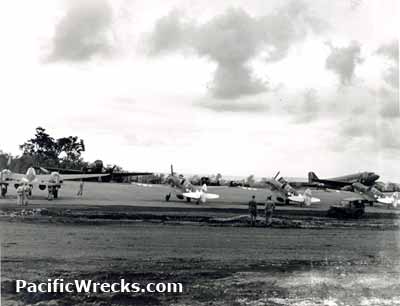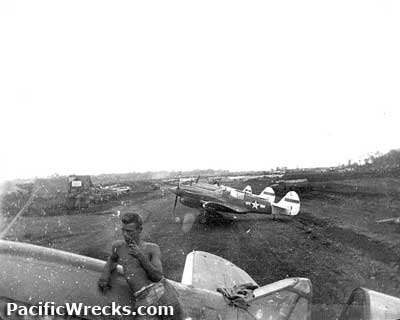|
|
|
|
| Missing In Action (MIA) | Prisoners Of War (POW) | Unexploded Ordnance (UXO) |
| Chronology | Locations | Aircraft | Ships | Submit Info | How You Can Help | Donate |
|
 5th AF c1943  5th AF May 5, 1943  5th AF June 13, 1943  90th BG Nov 22, 1943   5th AF Dec 26, 1943  USMC December 31, 1943  5th AF c1944  Wallisch March 1944  June 16, 1944 |
Location Lat 5° 27' 32S Long 148° 25' 57E Cape Gloucester Airfield is located on the northern tip of Cape Gloucester in West New Britain Province in Papua New Guinea. Known to the Japanese as "Tuluvu Airfield". Construction Built prewar by the Australians as a single runway for civilian aircraft known as Cape Gloucester Airfield. During late late December 1942, after the Japanese built a second runway, the original runway became known as No. 1 Strip. The Japanese built second runway became known as Cape Gloucester No. 2 Strip, East Airfield or No. 2 Strip. Wartime History On December 17, 1942 at dawn under cloud cover, Tachikaze and Patrol Boat No. 39 landed 350 Japanese troops at Cape Gloucester. This detachment was under the overall command of Major Kiyomitsu Mukai, the construction battalion commander and rapidly secured Cape Gloucester Airfield (No. 1 Strip) and established a 40 km beachhead area. The Japanese immediately began improving and expanding the prewar runway and built a second runway (Cape Gloucester No. 2 Strip, East Airfield). Once built, the original runway became known as Cape Gloucester No. 1 (Old Strip, West Airfield). Cape Gloucester Airfield was used by the Japanese as a forward airfield for fighters and bombers from both the Japanese Army Air Force (JAAF) and Imperial Japanese Navy (IJN). On July 30, 1943 a pair of Type 96 G3M Nells from the 11th Air Fleet escorted by sixteen A6M Zeros including three from the 201 Kokutai that landed with the bombers at Cape Gloucester. Aboard one was Vice-Admiral Junichi Kusaka, commander of the Southeast Area Fleet and his staff for a brief inspection then departed transporting Major General Iwasa Shun. That same day, three Type 2 fighters (Ki-45kai Nick) from the 13th Sentai arrived as the first fighters based at the airfield. On August 2, 1943 a Ki-51 Sonia from the 83rd Dokuritsu Chutai with passenger Lt. General Hatazo Adachi took off from Madang Airfield on a bound for Lae Airfield escorted by nine Ki-43 Oscars from the 24th Hiko Sentai (24th Flying Regiment). Flying at 4,900', the formation was spotted by P-38 Lightnings escorting B-25 Mitchells off Teliata Point on the north coast of New Guinea roughly 30 miles south of Saidor. To flee, the Sonia dove to low level and managed to escape interception and flew eastward then landed safely at Cape Gloucester Airfield. By October 19, 1943 Cape Gloucester Airfield defenses included 12 heavy anti-aircraft guns and 34 light anti-aircraft batteries including fake "dummy" gun positions. Japanese units based at Tuluvu / Cape Gloucester 13th Sentai (3 x Ki-45 Nick) July 30, 1943 26th Sentai (Ki-51 Sonia) 83rd Dokuritsu Chutai / 83rd Independent Air Chutai (Ki-51 Sonia) Cape Gloucester Airfield was targeted by American bombers and fighters in late December 1942 until the U.S. landing on December 26, 1943. The area was so heavily bombed by the 5th Air Force (5th AF) a new term was coined, "to Gloucesterize" a target. American missions against Cape Gloucester December 23, 1942–January 29, 1944 After the December 26, 1943 landing by the 1st Marine Division at Cape Gloucester, the Japanese 53rd Infantry commanded by Col. Kouki Sumiya fell back to Cape Gloucester Airfield on December 29 and centered their defense on "Razorback Hill" a ridge with bunkers that spans across the southwest approach to the airfield. The 5th Marines 1st Battalions and 2nd Battalions attacked this area on December 30 supported by tanks and artillery. Overpowered, Japanese were defeated by dusk. On December 30, 1943 U.S. Marines occupied Cape Gloucester Airfield. On December 31, 1943 U.S. Marine Corps (USMC) General William H. Rupertus held a U.S. flag raising ceremony near G4M1 Betty on No. 2 Strip. Later on March 11, 1944 Colonel Oliver P. Smith and Lieutenant Colonel Henry W. Buse with a color guard of the 3rd Battalion, 5th Marines raised the same U.S. flag at Bitokara. After capturing Cape Gloucester, the Marines located intact Ki-61 Tony 263. This aircraft was immediately recovered and transported to Australia for technical evaluation. Many other wrecks were surveyed by ATIU (Air Technical Intelligence Unit). Japanese aircraft captured at Cape Gloucester Airfield Captured December 30, 1943 During January 1944, American forces worked to repair the runway but heavy rains delayed repairs until the end of the month. As of January 31, 1944 the runway was 4,500' x 100', with a parallel runway under construction and the west runway used as a crash strip. American units based at Cape Gloucester 8th FG, 35th FS (P-40) Finschafen arrives February 19, 1944–March 14, 1944 departs Nadzab 8th FG, 36th FS (P-47) Finschafen arrives February 19, 1944–March 14, 1944 departs Nadzab 8th FG, 80th FS (P-38s) Dobodura arrives Feb 24 - March 25, 1944 departs Nadzab 6th PRG 8th PRS (F-4, F-5) 12th Defense Battalion (USMC) Dec 30, 1943 - late May 1944 Australian units based at Cape Gloucester 78 Squadron (P-40s) March - April 25, 1944 to Tadji Robert Rocker adds: "The 36th FS and 80th FS were based at Gloucester in March of 1944, but it was raining so much in April they pulled both squadrons back into New Guinea. Bill Wallisch a 35th FS Crew Chief told me the mud was so bad there that they just could not operate properly." Cape Gloucester I (Old Strip, West Airfield) Lat 5° 27' 32S Long 148° 25' 57E Cape Gloucester I is located to the west, running roughly north-west to south-east, nearest to the ocean. Built prewar by the Australian administration. The single runway was 600 yards long. When the Japanese occupied the airfield on December 17, this runway was unserviceable due to trench barricades, erosion, floodwaters and vegetation. Surveyed by on December 20, the Japanese decided to build a new runway adjacent to this runway. When completed, the runway was expanded to 3,900' runway and a series of revetments were built along the eastern edge of the strip. Largely abandoned by the Japanese, it was overgrown when captured by Marines in December 1943. Reportedly, this strip was repaired and used until 1990s, when it was deemed unsafe. Cape Gloucester II (No. 2 Strip, East Strip, New Airfield) This runway runs east to west. Built prewar by Australians, 750 yards long. When the Japanese occupied the airfield on December 17, 1942 this runway was unserviceable due to trench barricades, erosion, floodwaters and vegetation. Afterwards, the Japanese began repairing and expanding the runway. On January 15, 1943 the first phase of construction was completed with a runway measuring 3,773' x 328' (1,150m x 100m) and deemed usable for emergency landings. On February 1, 1943 at 9am, a Ki-61 Dinah piloted by 1Lt. Okano and Sgt. Major Kanaya landed but, flipped over damaging the aircraft and injuring the crew. Next on February 5, four aircraft landed at 6am, likely Ki-43 Oscars of the 11th Sentai, en route from Rabaul to Lae. By February 16, the runway was observed as 3,900', later expanded to 4,500' in length, with a large dispersal loop and taxiway to the north side. This was the primary Japanese strip at Cape Gloucester. Several wrecked and some intact Japanese Navy and Army aircraft were captured at this location. Repaired and expanded by the Americans. Post war, it was disused and overgrown today. Today Still in use today, known as "Cape Gloucester Airport". Airport code: IATA: CGC. Serviced by secondary airlines. Occasionally, nearby volcanic eruptions temporarily close the runway. Brian Bennett adds: "I found the old dump at Cape Gloucester some years ago but you would need to move a bit of dirt to get at it. I recall that there were bits of Japanese aircraft sticking out of the ground." References Engineers in Theater Operations [Pacific] "Advance Area Airdromes 31 January 1944", Map No. 24 Airdromes Guide Southwest Pacific Area - 1 July 1945 Cape Gloucester: The Green Inferno by Bernard C. Nalty, Marine Corps Heritage Center, 1994 Tuluvu's Air War by Richard Dunn Tuluvu's Air War: Chapter V High Ranking Visitors by Richard Dunn Contribute
Information Last Updated
|
Map 1943 Map Dec 26, 1943 Map Fallingrain Photo Archive |
| Discussion Forum | Daily Updates | Reviews | Museums | Interviews & Oral Histories |
|